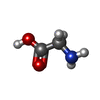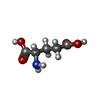+ データを開く
データを開く
- 基本情報
基本情報
| 登録情報 | データベース: PDB / ID: 7yfg | ||||||
|---|---|---|---|---|---|---|---|
| タイトル | Structure of the Rat GluN1-GluN2C NMDA receptor in complex with glycine and glutamate (major class in asymmetry) | ||||||
 要素 要素 | (Glutamate receptor ionotropic, NMDA ...) x 2 | ||||||
 キーワード キーワード | MEMBRANE PROTEIN / NMDA receptor / GluN2C | ||||||
| 機能・相同性 |  機能・相同性情報 機能・相同性情報directional locomotion / pons maturation / regulation of cell communication / positive regulation of Schwann cell migration / EPHB-mediated forward signaling / Assembly and cell surface presentation of NMDA receptors / olfactory learning / conditioned taste aversion / dendritic branch / regulation of respiratory gaseous exchange ...directional locomotion / pons maturation / regulation of cell communication / positive regulation of Schwann cell migration / EPHB-mediated forward signaling / Assembly and cell surface presentation of NMDA receptors / olfactory learning / conditioned taste aversion / dendritic branch / regulation of respiratory gaseous exchange / protein localization to postsynaptic membrane / propylene metabolic process / response to glycine / voltage-gated monoatomic cation channel activity / regulation of monoatomic cation transmembrane transport / response to morphine / NMDA glutamate receptor activity / Synaptic adhesion-like molecules / NMDA selective glutamate receptor complex / glutamate-gated calcium ion channel activity / RAF/MAP kinase cascade / parallel fiber to Purkinje cell synapse / calcium ion transmembrane import into cytosol / protein heterotetramerization / glutamate binding / neuromuscular process / positive regulation of reactive oxygen species biosynthetic process / regulation of synapse assembly / glycine binding / positive regulation of calcium ion transport into cytosol / regulation of dendrite morphogenesis / regulation of axonogenesis / male mating behavior / suckling behavior / startle response / response to amine / monoatomic cation transmembrane transport / monoatomic cation transport / regulation of neuronal synaptic plasticity / associative learning / positive regulation of excitatory postsynaptic potential / social behavior / ligand-gated monoatomic ion channel activity / neuromuscular process controlling balance / cellular response to glycine / excitatory synapse / positive regulation of dendritic spine maintenance / Unblocking of NMDA receptors, glutamate binding and activation / phosphatase binding / cellular response to manganese ion / calcium ion homeostasis / glutamate receptor binding / prepulse inhibition / monoatomic cation channel activity / long-term memory / regulation of neuron apoptotic process / synaptic cleft / glutamate-gated receptor activity / presynaptic active zone membrane / response to fungicide / sensory perception of pain / dendrite membrane / ligand-gated monoatomic ion channel activity involved in regulation of presynaptic membrane potential / response to amphetamine / ionotropic glutamate receptor signaling pathway / excitatory postsynaptic potential / hippocampal mossy fiber to CA3 synapse / positive regulation of synaptic transmission, glutamatergic / adult locomotory behavior / learning / synaptic membrane / synaptic transmission, glutamatergic / transmitter-gated monoatomic ion channel activity involved in regulation of postsynaptic membrane potential / PDZ domain binding / regulation of membrane potential / long-term synaptic potentiation / postsynaptic density membrane / regulation of long-term neuronal synaptic plasticity / calcium channel activity / visual learning / regulation of synaptic plasticity / negative regulation of protein catabolic process / response to organic cyclic compound / terminal bouton / cerebral cortex development / memory / synaptic vesicle membrane / response to wounding / intracellular calcium ion homeostasis / response to calcium ion / neuron cellular homeostasis / calcium ion transport / rhythmic process / synaptic vesicle / presynaptic membrane / signaling receptor activity / amyloid-beta binding / protein-containing complex assembly / chemical synaptic transmission / postsynaptic membrane 類似検索 - 分子機能 | ||||||
| 生物種 |  | ||||||
| 手法 | 電子顕微鏡法 / 単粒子再構成法 / クライオ電子顕微鏡法 / 解像度: 3.6 Å | ||||||
 データ登録者 データ登録者 | Zhang, M. / Zhang, J. / Guo, F. / Li, Y. / Zhu, S. | ||||||
| 資金援助 |  中国, 1件 中国, 1件
| ||||||
 引用 引用 |  ジャーナル: Nat Struct Mol Biol / 年: 2023 ジャーナル: Nat Struct Mol Biol / 年: 2023タイトル: Distinct structure and gating mechanism in diverse NMDA receptors with GluN2C and GluN2D subunits. 著者: Jilin Zhang / Ming Zhang / Qinrui Wang / Han Wen / Zheyi Liu / Fangjun Wang / Yuhang Wang / Fenyong Yao / Nan Song / Zengwei Kou / Yang Li / Fei Guo / Shujia Zhu /  要旨: N-methyl-D-aspartate (NMDA) receptors are heterotetramers comprising two GluN1 and two alternate GluN2 (N2A-N2D) subunits. Here we report full-length cryo-EM structures of the human N1-N2D di- ...N-methyl-D-aspartate (NMDA) receptors are heterotetramers comprising two GluN1 and two alternate GluN2 (N2A-N2D) subunits. Here we report full-length cryo-EM structures of the human N1-N2D di-heterotetramer (di-receptor), rat N1-N2C di-receptor and N1-N2A-N2C tri-heterotetramer (tri-receptor) at a best resolution of 3.0 Å. The bilobate N-terminal domain (NTD) in N2D intrinsically adopts a closed conformation, leading to a compact NTD tetramer in the N1-N2D receptor. Additionally, crosslinking the ligand-binding domain (LBD) of two N1 protomers significantly elevated the channel open probability (Po) in N1-N2D di-receptors. Surprisingly, the N1-N2C di-receptor adopted both symmetric (minor) and asymmetric (major) conformations, the latter further locked by an allosteric potentiator, PYD-106, binding to a pocket between the NTD and LBD in only one N2C protomer. Finally, the N2A and N2C subunits in the N1-N2A-N2C tri-receptor display a conformation close to one protomer in the N1-N2A and N1-N2C di-receptors, respectively. These findings provide a comprehensive structural understanding of diverse function in major NMDA receptor subtypes. #1:  ジャーナル: Nat.Struct.Mol.Biol. / 年: 2023 ジャーナル: Nat.Struct.Mol.Biol. / 年: 2023タイトル: Distinct structure and gating mechanism in diverse NMDA receptors with GluN2C and GluN2D subunits 著者: Zhang, M. / Zhu, S. | ||||||
| 履歴 |
|
- 構造の表示
構造の表示
| 構造ビューア | 分子:  Molmil Molmil Jmol/JSmol Jmol/JSmol |
|---|
- ダウンロードとリンク
ダウンロードとリンク
- ダウンロード
ダウンロード
| PDBx/mmCIF形式 |  7yfg.cif.gz 7yfg.cif.gz | 477.7 KB | 表示 |  PDBx/mmCIF形式 PDBx/mmCIF形式 |
|---|---|---|---|---|
| PDB形式 |  pdb7yfg.ent.gz pdb7yfg.ent.gz | 393.6 KB | 表示 |  PDB形式 PDB形式 |
| PDBx/mmJSON形式 |  7yfg.json.gz 7yfg.json.gz | ツリー表示 |  PDBx/mmJSON形式 PDBx/mmJSON形式 | |
| その他 |  その他のダウンロード その他のダウンロード |
-検証レポート
| 文書・要旨 |  7yfg_validation.pdf.gz 7yfg_validation.pdf.gz | 2 MB | 表示 |  wwPDB検証レポート wwPDB検証レポート |
|---|---|---|---|---|
| 文書・詳細版 |  7yfg_full_validation.pdf.gz 7yfg_full_validation.pdf.gz | 2.1 MB | 表示 | |
| XML形式データ |  7yfg_validation.xml.gz 7yfg_validation.xml.gz | 89.1 KB | 表示 | |
| CIF形式データ |  7yfg_validation.cif.gz 7yfg_validation.cif.gz | 129.6 KB | 表示 | |
| アーカイブディレクトリ |  https://data.pdbj.org/pub/pdb/validation_reports/yf/7yfg https://data.pdbj.org/pub/pdb/validation_reports/yf/7yfg ftp://data.pdbj.org/pub/pdb/validation_reports/yf/7yfg ftp://data.pdbj.org/pub/pdb/validation_reports/yf/7yfg | HTTPS FTP |
-関連構造データ
| 関連構造データ |  33789MC  7yffC  7yfhC  7yfiC  7yflC  7yfmC  7yfoC  7yfrC  8hdkC M: このデータのモデリングに利用したマップデータ C: 同じ文献を引用 ( |
|---|---|
| 類似構造データ | 類似検索 - 機能・相同性  F&H 検索 F&H 検索 |
- リンク
リンク
- 集合体
集合体
| 登録構造単位 | 
|
|---|---|
| 1 |
|
- 要素
要素
-Glutamate receptor ionotropic, NMDA ... , 2種, 4分子 ACBD
| #1: タンパク質 | 分子量: 97574.625 Da / 分子数: 2 / 由来タイプ: 組換発現 / 由来: (組換発現)   Homo sapiens (ヒト) / 参照: UniProt: P35439 Homo sapiens (ヒト) / 参照: UniProt: P35439#2: タンパク質 | 分子量: 87753.758 Da / 分子数: 2 / 由来タイプ: 組換発現 / 由来: (組換発現)   Homo sapiens (ヒト) / 参照: UniProt: Q00961 Homo sapiens (ヒト) / 参照: UniProt: Q00961 |
|---|
-糖 , 3種, 30分子 
| #3: 多糖 | 2-acetamido-2-deoxy-beta-D-glucopyranose-(1-4)-2-acetamido-2-deoxy-beta-D-glucopyranose #4: 多糖 | alpha-D-mannopyranose-(1-4)-2-acetamido-2-deoxy-beta-D-glucopyranose-(1-4)-2-acetamido-2-deoxy-beta- ...alpha-D-mannopyranose-(1-4)-2-acetamido-2-deoxy-beta-D-glucopyranose-(1-4)-2-acetamido-2-deoxy-beta-D-glucopyranose | #5: 糖 | ChemComp-NAG / |
|---|
-非ポリマー , 2種, 4分子 


| #6: 化合物 | | #7: 化合物 | |
|---|
-詳細
| 研究の焦点であるリガンドがあるか | N |
|---|
-実験情報
-実験
| 実験 | 手法: 電子顕微鏡法 |
|---|---|
| EM実験 | 試料の集合状態: PARTICLE / 3次元再構成法: 単粒子再構成法 |
- 試料調製
試料調製
| 構成要素 | 名称: Rat GluN1-GluN2C NMDA receptor in complex with glycine and glutamate タイプ: ORGANELLE OR CELLULAR COMPONENT / Entity ID: #1-#2 / 由来: RECOMBINANT |
|---|---|
| 分子量 | 実験値: NO |
| 由来(天然) | 生物種:  |
| 由来(組換発現) | 生物種:  Homo sapiens (ヒト) Homo sapiens (ヒト) |
| 緩衝液 | pH: 8 |
| 試料 | 濃度: 4.2 mg/ml / 包埋: NO / シャドウイング: NO / 染色: NO / 凍結: YES |
| 試料支持 | グリッドの材料: GOLD / グリッドのサイズ: 300 divisions/in. / グリッドのタイプ: Quantifoil R1.2/1.3 |
| 急速凍結 | 装置: FEI VITROBOT MARK IV / 凍結剤: ETHANE / 湿度: 100 % / 凍結前の試料温度: 281 K |
- 電子顕微鏡撮影
電子顕微鏡撮影
| 実験機器 |  モデル: Titan Krios / 画像提供: FEI Company |
|---|---|
| 顕微鏡 | モデル: FEI TITAN KRIOS |
| 電子銃 | 電子線源:  FIELD EMISSION GUN / 加速電圧: 300 kV / 照射モード: FLOOD BEAM FIELD EMISSION GUN / 加速電圧: 300 kV / 照射モード: FLOOD BEAM |
| 電子レンズ | モード: BRIGHT FIELD / 最大 デフォーカス(公称値): 2000 nm / 最小 デフォーカス(公称値): 1200 nm |
| 撮影 | 電子線照射量: 60 e/Å2 フィルム・検出器のモデル: DIRECT ELECTRON DE-10 (5k x 4k) |
| 画像スキャン | 横: 5760 / 縦: 9042 |
- 解析
解析
| EMソフトウェア |
| ||||||||||||||||||||||||||||
|---|---|---|---|---|---|---|---|---|---|---|---|---|---|---|---|---|---|---|---|---|---|---|---|---|---|---|---|---|---|
| CTF補正 | タイプ: PHASE FLIPPING AND AMPLITUDE CORRECTION | ||||||||||||||||||||||||||||
| 粒子像の選択 | 選択した粒子像数: 1188229 | ||||||||||||||||||||||||||||
| 対称性 | 点対称性: C1 (非対称) | ||||||||||||||||||||||||||||
| 3次元再構成 | 解像度: 3.6 Å / 解像度の算出法: FSC 0.143 CUT-OFF / 粒子像の数: 245730 / 対称性のタイプ: POINT |
 ムービー
ムービー コントローラー
コントローラー











 PDBj
PDBj








